|
Brian's Guitar from Conception to Birth
or How to Build a Guitar in 62 Easy Steps! |
|
13
Rough Cut the Neck's Shape |
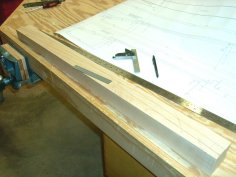 |
 |
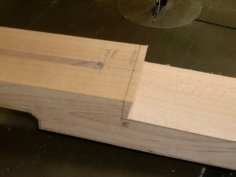 |
All of your layout lines should still be on the top of the neck.
Some of those can be transferred to the side of the neck. A few
other dimensions youíll have to ďcarefullyĒ mark (thereís that word
again). The neck on our guitar actually penetrates about a foot into
the body. This takes a little more layout and a few more cuts. After
double-checking your marks, cut out the shape on the bandsaw about
2mm outside your lines. I gave about a 5mm margin where the end of
our fretboard jogs to penetrate the body. I want to double (and
triple) check that the end of the fretboard will be exactly where I
want it. I wonít cut this until after the neck is dry-fit to the
body.
 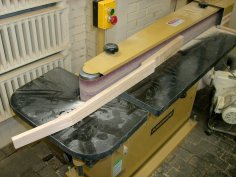 Now
you just have a lot of clean up to do to get your cuts to be
precisely up to your layout lines. The first photo to the right
shows a horizontal/ vertical edge sander. This is a great tool if
you have access to one. This will take care of leveling most of your
straight edges. Just slowly work up to your layout lines with light
pressure. For tighter areas and curves, use an oscillating drum
sander (second photo). You can also use this on straight edges you
couldnít reach with the previous sander. Just pay more attention to
creeping up on your layout in a straight line avoiding any
scalloping by pressing too hard in one spot. If you donít have
access to these tools, youíre shit out of luck. It will take a lot
longer using hand planes, belt sanders, and orbital sanders. Now
you just have a lot of clean up to do to get your cuts to be
precisely up to your layout lines. The first photo to the right
shows a horizontal/ vertical edge sander. This is a great tool if
you have access to one. This will take care of leveling most of your
straight edges. Just slowly work up to your layout lines with light
pressure. For tighter areas and curves, use an oscillating drum
sander (second photo). You can also use this on straight edges you
couldnít reach with the previous sander. Just pay more attention to
creeping up on your layout in a straight line avoiding any
scalloping by pressing too hard in one spot. If you donít have
access to these tools, youíre shit out of luck. It will take a lot
longer using hand planes, belt sanders, and orbital sanders.
|
 |
 |
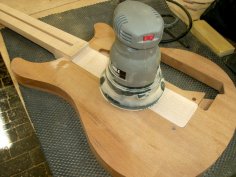 |
Now itís time for a test fit. Donít worry, no matter what youíve
done or how careful you measured, it will not fit right the first
time. If your neck is a little wide, use a sanding block on the
sides of the cavity to creep up to a snug, but not too tight a fit.
Donít sand the edges of the neck as it will screw up your fretboard
width or make for some other weird transition. Remember to take a
little off of each side to keep the neck centered. If you need a
hammer to set the neck, itís still too tight (and youíll likely
wedge both halves of the back body panel apart). If your fit is a
little loose, some strategically placed shims glued into place will
take up the slack (and no one will know). If youíre off by more than
2mm, you messed up somewhere. That large a gap (yeah, even 2mm) is
telling you that something wasnít laid out correctly (itís really
telling you that youíre a hack and shouldnít be building a guitar in
the first place!). Go back and check all of your measurements. You
might have to go back to the start if you screwed up too badly. Once
your neck slides smoothly into position with only minor friction,
sand the portion where the neck penetrates the back body panel
perfectly flush.
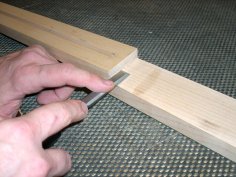 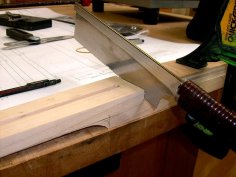 Now
itís time to cut the end of the fretboard to itís exact position.
Check your distance from nut to bridge. Hopefully youíll be right on
or very close. The end of our fretboard abuts the neck pickupís
cover plate. I marked the exact location on the neck and made the
cut with my trusty Japanese pull-saw. I cleaned up the corner with
chisels and sandpaper. Be sure to spend plenty of time getting the
neck accurate and true. This is the most important part of the
instrument and will directly affect the playability and intonation
of the guitar. Now
itís time to cut the end of the fretboard to itís exact position.
Check your distance from nut to bridge. Hopefully youíll be right on
or very close. The end of our fretboard abuts the neck pickupís
cover plate. I marked the exact location on the neck and made the
cut with my trusty Japanese pull-saw. I cleaned up the corner with
chisels and sandpaper. Be sure to spend plenty of time getting the
neck accurate and true. This is the most important part of the
instrument and will directly affect the playability and intonation
of the guitar. |